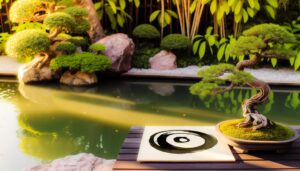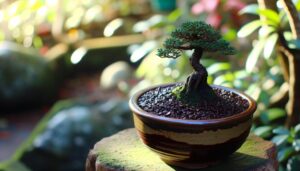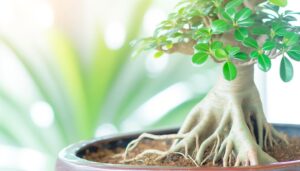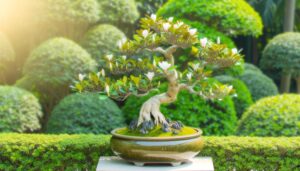How Do Bonsai Trees Change Color?
Yes, bonsai trees change color, particularly deciduous species. These shifts are driven by environmental factors such as temperature, photoperiod, and humidity.
During autumn, degradation of chlorophyll and accumulation of anthocyanins and carotenoids create vibrant hues. Evergreens, however, generally retain their foliage year-round.
Species-specific care, including precise irrigation, fertilization, and light management, influences these color dynamics. Variations in nutrient availability and soil composition also affect color changes.
Understanding the physiological and environmental interplay is essential for enhancing the aesthetic appeal of bonsai trees throughout the year. Learning more about these practices will provide deeper insights into optimizing bonsai coloration.
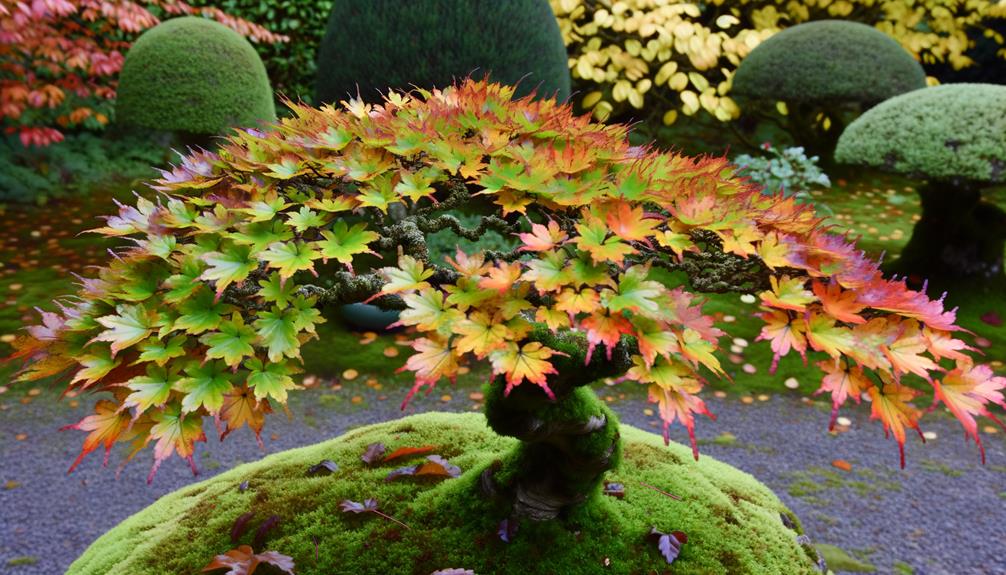
Key Takeaways
- Yes, bonsai trees, especially deciduous varieties, exhibit seasonal color changes due to environmental factors.
- Color shifts in bonsai trees are influenced by temperature, light, water availability, and soil composition.
- Chlorophyll degradation and pigment accumulation cause vibrant seasonal displays in bonsai trees.
- Understanding species-specific requirements enhances the color and health of bonsai trees.
- Horticultural practices like balanced fertilization and precise irrigation improve bonsai tree color changes.
Types of Bonsai Trees

Bonsai trees encompass a diverse array of species, each with unique morphological characteristics and specific cultivation requirements. Common species include Juniperus (Juniper), Acer palmatum (Japanese Maple), and Ficus retusa.
Junipers are coniferous, exhibiting needle-like foliage and demanding well-drained soil and full sunlight. Japanese Maples, known for their palmate leaves, thrive in partial shade and require frequent watering due to their shallow root systems. Ficus retusa, a tropical species, features broad, glossy leaves and necessitates high humidity and indirect light.
Each species' distinctive growth patterns and environmental needs mandate precise horticultural practices. Understanding these variations is critical for successful cultivation, ensuring ideal health and aesthetics in bonsai art.
Seasonal Color Changes
Seasonal color shifts in bonsai trees are primarily influenced by species-specific physiological responses to varying environmental conditions such as temperature, light, and humidity. These changes are a result of complex biochemical processes that prepare the trees for different seasonal phases.
For example, chlorophyll degradation and the accumulation of anthocyanins and carotenoids can lead to vibrant displays.
Key factors influencing seasonal color shifts include:
- Temperature fluctuations: Cooler temperatures often trigger color transformations.
- Photoperiod: The length of daylight affects pigment synthesis.
- Water availability: Hydration levels can impact leaf coloration.
- Soil composition: Nutrient availability in soil affects tree health and color.
- Humidity levels: Relative humidity influences transpiration and metabolic activities.
Understanding these factors provides insights into the dynamic beauty of bonsai trees throughout the year.
Deciduous Bonsai Varieties

Deciduous bonsai varieties exhibit pronounced seasonal color changes, with foliage shifting from vibrant greens to striking autumnal hues, such as reds, yellows, and oranges, before leaf abscission.
These transformations are driven by physiological processes, including chlorophyll degradation and anthocyanin accumulation.
Care and maintenance practices, such as precise irrigation, controlled fertilization, and appropriate pruning, are critical to optimizing the health and aesthetic appeal of these bonsai throughout their seasonal cycles.
Seasonal Color Changes
The pigmentation of deciduous bonsai trees undergoes significant transformations throughout the year due to physiological responses to changing environmental conditions. These transformations are driven by variations in light intensity, temperature fluctuations, and hormonal changes within the plant.
Key seasonal color changes include:
- Spring: Emergence of new leaves with vibrant, fresh green hues.
- Summer: Mature leaves exhibit deeper green shades due to increased chlorophyll production.
- Autumn: Decline in chlorophyll reveals underlying pigments, such as carotenoids and anthocyanins, resulting in yellow, orange, and red foliage.
- Winter: Leaf abscission occurs, leaving the bonsai in a dormant state with bare branches.
- Early Spring: Buds begin to swell, indicating the commencement of a new growth cycle.
These dynamic changes are essential indicators of the tree's health and adaptation.
Care and Maintenance
Proper attention and upkeep of deciduous bonsai varieties require meticulous focus on watering schedules, soil composition, and pruning techniques to ensure health and aesthetic appeal.
Ensuring consistent hydration is pivotal, as these varieties are highly sensitive to both drought and waterlogging. A well-draining soil mix, typically composed of akadama, pumice, and lava rock, helps maintain ideal moisture levels.
Fertilization should be balanced, incorporating nitrogen, phosphorus, and potassium to support seasonal growth cycles. Pruning is essential for maintaining form and encouraging vigorous new growth; this includes both structural and maintenance pruning.
Additionally, monitoring for pests and diseases, such as aphids and fungal infections, is crucial. Each step in this regimen contributes to the vibrant seasonal color changes and longevity of deciduous bonsai.
Evergreen Bonsai Characteristics
Evergreen bonsai exhibit resilience and longevity, characterized by their ability to retain foliage throughout the year, which plays an important role in their overall health and aesthetic appeal. These trees, often derived from species such as Juniperus, Pinus, and Picea, maintain a consistent green hue, due to their unique physiological adaptations.
Key characteristics include:
- Persistent foliage: Retains leaves or needles year-round.
- Adapted root systems: Efficient nutrient and water absorption.
- Compact growth: Dense branching and reduced leaf size.
- Photosynthetic efficiency: Continuous energy production.
- Resilience to stress: Enhanced survival in varying conditions.
These attributes make evergreen bonsai highly valued in horticulture for both their beauty and symbolic representation of endurance. Understanding these characteristics is essential for proper bonsai management.
Environmental Influences
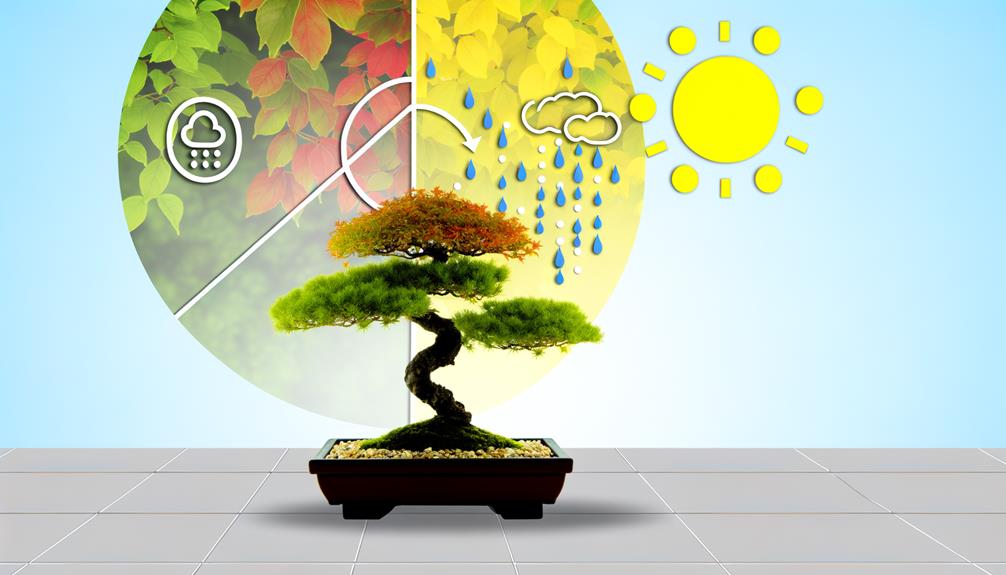
While environmental factors like light, temperature, and humidity profoundly impact the color changes in bonsai trees, understanding the specific requirements of each species is essential for best growth and vibrant foliage.
Light intensity and duration can stimulate photosynthetic activity, influencing pigment production. Temperature fluctuations, especially seasonal changes, trigger physiological responses, such as anthocyanin production, which can alter leaf coloration. Humidity levels affect transpiration rates, impacting water and nutrient absorption, subsequently influencing foliage color.
For example, high humidity fosters lush, green leaves, while low humidity may result in stressed, discolored foliage. Ideal environmental conditions tailored to the bonsai species ensure not only aesthetic appeal but also overall plant health, making environmental management a crucial aspect of bonsai cultivation.
Nutrient and Soil Impact
In addition to environmental factors, nutrient availability, and soil composition greatly influence the coloration and overall health of bonsai trees. Adequate nutrients are essential for the physiological processes that drive pigmentation in foliage.
- Nitrogen: Essential for chlorophyll production, influencing green pigmentation.
- Phosphorus: Essential for root development, indirectly affecting leaf color.
- Potassium: Enhances overall vigor and resistance to diseases, impacting color retention.
- Iron: Essential for chlorophyll synthesis, preventing chlorosis.
- Micronutrients: Elements like magnesium and calcium are indispensable for maintaining vibrant leaf colors.
The soil composition, including pH and organic matter, also determines nutrient availability. Imbalanced soils can lead to nutrient deficiencies, causing color changes such as yellowing or browning.
Hence, maintaining ideal soil conditions is crucial for the aesthetic and physiological health of bonsai trees.
Common Color Patterns
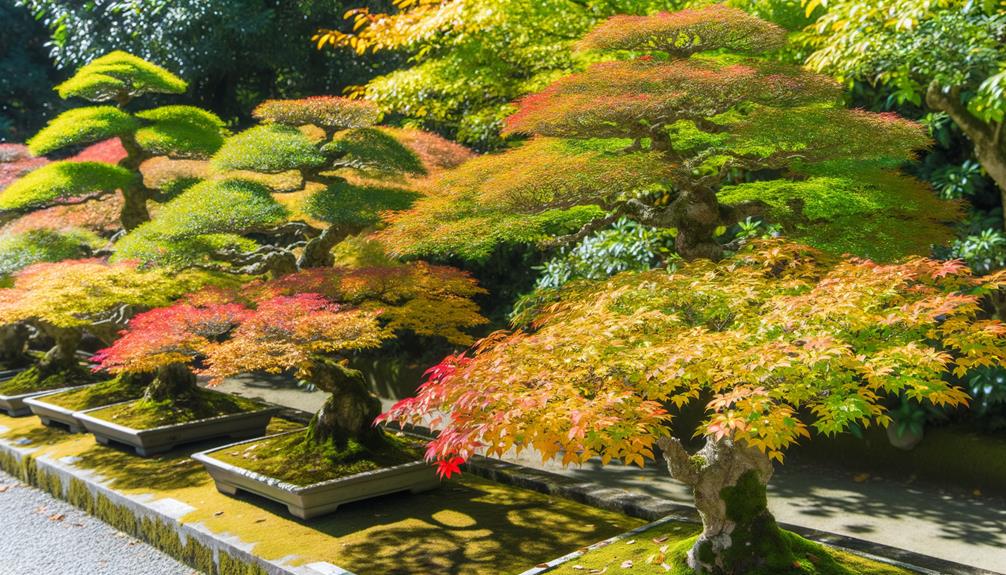
Common color patterns in bonsai trees are influenced by both seasonal changes and species-specific genetic traits. During different seasons, chlorophyll breakdown and anthocyanin production can lead to a spectrum of color variations, from vibrant reds to deep purples.
Additionally, species such as Acer palmatum exhibit distinct color transformations that are inherent to their genetic makeup, contributing to their unique aesthetic appeal.
Seasonal Color Changes
The phenological shifts in bonsai trees result in distinct seasonal color changes. This progression starts with vibrant greens in spring and transitions to rich hues of red, orange, and yellow in autumn. These changes are driven by alterations in chlorophyll levels and the production of anthocyanins and carotenoids. Environmental factors like light, temperature, and water availability influence this process.
Understanding these patterns can aid in ideal bonsai care and enhance their aesthetic value throughout the year.
Spring:
Emergence of fresh, vivid green foliage.
Summer:
Deepening of green shade, often with a shiny sheen.
Early Autumn:
Gradual shift to gold, orange, and red tones.
Late Autumn:
Intensification of red and orange shades.
Winter:
Possible browning or shedding of leaves, depending on species.
Species-Specific Variations
Different bonsai species exhibit unique color patterns throughout the seasons, driven by their specific genetic makeup and physiological responses to environmental stimuli.
For instance, Acer palmatum (Japanese Maple) bonsai display vibrant reds and oranges in autumn due to anthocyanin pigment accumulation.
Conversely, Pinus thunbergii (Japanese Black Pine) maintains a consistent green hue year-round, attributed to its evergreen nature and stable chlorophyll levels.
Juniperus chinensis (Chinese Juniper) can exhibit a bluish-green tint, with foliage sometimes turning purplish in colder months due to stress-induced anthocyanins.
Each species' chromatic shifts are influenced by factors such as light exposure, temperature fluctuations, and water availability, underscoring the complex interplay between genetic predisposition and environmental conditions in bonsai coloration.
Enhancing Bonsai Colors
Regularly practicing specific horticultural methods can greatly enhance the vibrancy and variety of colors in bonsai trees. These methods involve careful attention to environmental conditions, watering, and nutrient management. By optimizing these factors, practitioners can induce more vivid pigmentation and seasonal color changes.
To achieve best results, consider the following practices:
- Light Exposure: Guarantee sufficient sunlight to promote photosynthetic efficiency and vibrant leaf coloration.
- Watering Practices: Maintain consistent moisture levels to prevent stress-induced color fading.
- Nutrient Management: Use balanced fertilizers to supply essential macro and micronutrients.
- Pruning Techniques: Regular pruning can stimulate new growth with enhanced color intensity.
- Soil Composition: Utilize well-draining soils to guarantee root health and prevent nutrient deficiencies.
Conclusion
To conclude, bonsai trees showcase a range of color changes affected by seasonal fluctuations, species distinctions, and environmental circumstances.
Deciduous types present a vibrant range of colors, while evergreens uphold a consistent shade. Nutrient availability and soil makeup additionally adjust these color shifts.
Regular trends arise as a confirmation of the complex interaction of elements, elevating the visual attractiveness. Therefore, the vibrant display of colors in bonsai trees is a harmonious display guided by nature's intricate systems, providing a visual delight of scientific wonder.

